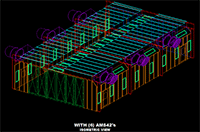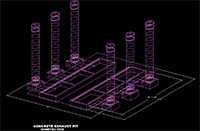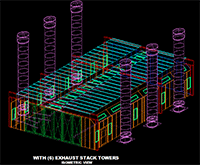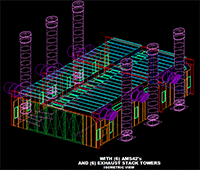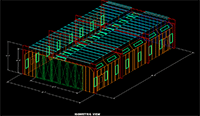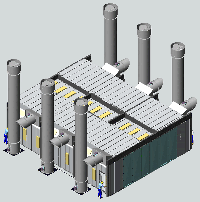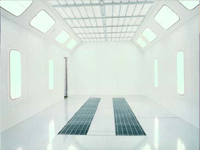|
|
|
|
RSI In-Floor Downdraft Sanding & Grinding Rooms RSI Sanding Rooms are designed to fit your
application, not your application to the room. Whether the
product is a large aircraft or a multitude of product components, we
will design the room to fit your product. RSI Downdraft Sanding Rooms are designed with up
to 100% filtered air circulation, using either cartridge or
multi-pocket bag filters. RSI Sanding Rooms can be zoned separately by using
80 mil. Fire retardant plastic curtains so personnel can confidently
work it their own cells with minimum outside interference. RSI carefully studies your MSDS coating
specifications prior to making filtration recommendations. The
amount of turnovers and amount of recirculated air will be
determined by these factors. This will reduce the over-all
exposure levels to personnel working throughout the room.
Progressive ISOMETRIC Designs
A standard rule for many years has been a velocity
of 100 feet per minute (FPM).
Due to the popularity of down draft spray booths, and the air
now moving in a downward direction instead of a cross direction, the
velocity of the air must be lower than 100 FPM to achieve desirable
effects on a prep & or paint job. Due to this design change, the NFPA has changed
the ventilation requirements of spray booths.
In the 2000 NFPA 33,
section 5.2, the code states that the ventilation system be “capable
of confining and removing vapors and mists to a safe location and is
capable of confining and controlling combustible residues, dusts,
and deposits. The concentration of the vapors and mists in the
exhaust stream of the ventilation system shall not exceed 25 percent
of the lower flammable limit “LFL”.” In section A.5.2, which defines the lower
flammable limit, under “Spray Booths”, the code reads, “In general,
if vapors, mists, and residues move towards the filters and the
exhaust ducts, they will be confined and controlled.” First we have to figure out
the cubic feet that our booth has, this particular booth is 20’wide
x 12’high x 20’ long.
Our booth also has 45º corners and 45º
sloped roof and corners.
By calculating all these variables I
come up with 4,620 cubic feet.
The NFPA 33 Annex B section B.1 calls
out a safety factor of 4 to 1 for ventilation requirements. If we keep the requested 100
FPM then we would have to move (20’ W x 20’ D) x 100=40,000 CFM
based on the cross section that the air is moving in this case
downwards.
Take the total CFM divided by the total
cubic feet you get “40,000 ÷ 4,620 cubic feet” approximately 8.66
to 1 air changes per minute.
This would be the maximum air changes
that you could expect if the air filters were clean and the booth
was well maintained.
This 8.66 to 1 is far greater than the 4
to 1 ventilation requirements that are called out by the NFPA 33.
In fact it over twice the safety factor
of 4 to 1, thus meaning that the example in the book using a 1% LFL
would allow this booth to have roughly 5.5% LFL.
This is over 5 times the allowable LFL
for a normal spray booth. Now if you work the above
equation backwards 4,620 cubic feet x 4 which is the minimum
required air changes per NFPA 33 = 18,480 CFM.
If you went by the code then all you
would have to move in this booth for proper ventilation and
performance is 18,480 CFM.
|
|


